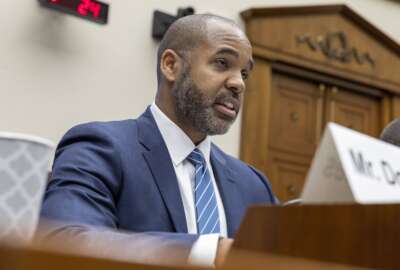Tips to make your agency more green
Federal News Radio has compiled a list of dos and don\'ts when it comes to making your agency or company more green.
There is a lot of talk about making your office and your agency more green, including simple actions such as turning off your computer when you leave the office for the evening or recycling cans and bottles. But there are other no-cost or low-cost and sometimes less obvious steps each employee can take to lower his or her office’s carbon footprint.
We contacted several experts for some insight into some easy dos and don’ts to make offices and data centers more energy efficient.
These tips come from:
- John Cantrell, sustainable design manager, HOK Atlanta;
- Shel Horowitz, author, Guerrilla Marketing Goes Green: Winning Strategies to Improve Your Profits and Your Planet;
- Chris Strammiello, vice president product management and product marketing, Nuance;
- Dale Wickizer, chief technology officer, NetApp U.S. Public Sector.
We also would love to hear from you. What are your dos and don’ts when it comes to making your agency more green?
Send us an email.
DOs:
- Make Document Scanning Available to Everyone. Decentralize scanning with multifunction peripherals (MFPs) and desktop scanners so anyone can scan documents into an office application. This step will allow the person most familiar with the information to capture documents, and reduce paper usage and printing.
- Improve Document Handling. Save time – and money – by unlocking the information that’s trapped within increasingly common PDF file format documents by utilizing document conversion software to convert those PDF documents into Word, Excel and other editable formats. This mitigates the costs of retyping documents.
- Resist the Urge to Print with Large Monitors. Monitor prices continue to drop. Larger monitors reduce eye strain and make it easy for everyone to view document images at their desktops. This will also advance an office’s green initiative by reducing paper consumption used in unnecessary printing.
- Lower ambient lighting levels and use task lamps for specific lighting needs. This gives the user localized control of their environments. Turn the lights off in rooms when not in use or install occupancy sensors.
- Replace standard incandescent bulbs with compact fluorescent lamps (CFLs) wherever possible. These use 75 percent less energy than standard incandescent light bulbs while delivering the same light output.
- Use light wall colors; light paint colors and higher gloss sheens reflect daylight, meaning your space will need less overhead lighting.
- At night, switch lights off in general office areas. Make sure everyone knows “the last one out turns off the lights” and encourage the cleaners to turn off lights when they are finished. Or, when possible, install timers that turn lights on and off at preset times.
- Take advantage of natural light whenever possible. Encourage employees to open window shades and remove objects blocking light coming into the workplace.
- Turn off the lights every time you leave a room (office, conference room, etc.). Or install motion sensors in conference rooms and restrooms that automatically turn lights off when there is no activity.
- Angle the lights correctly. If the light comes from the right direction, less light is needed.
- Adjust your thermostats properly. A one-degree change can save 10 % on your heating or cooling bill while cutting down on energy consumption and greenhouse gas emissions. Set thermostats between 69 and 71 degrees Fahrenheit for heating and between 75 and 77 degrees Fahrenheit for cooling.
- Ensure that furniture or other items do not block heating and cooling registers. If registers are blocked, the system has to work longer to achieve the desired level of comfort.
- Energy Star Equipment. Reduce energy use by purchasing personal computers and other electrical devices bearing the Energy Star certification label from the U.S. Department of Energy, which is granted to energy-efficient items.
- Orient new construction and renovation to take maximum advantage of sitting.
- Switch to duplexing printers (print on both sides of the page).
- Block air infiltration from outside-wall outlets and switchplates with foam insulators and baby safety protectors.
- Share computers, copiers, coffee makers, etc. among multiple users, plug them into power strips, and turn them OFF if no one is going to use them for an hour or more–especially when closing the office at night.
- Eliminate as much physical infrastructure as possible, thereby eliminating power and cooling requirements. Organizations should examine their data, application by application, to determine whether some or most of it can be housed in the cloud.
- Server virtualization is useful to reduce the physical footprint required in the data center by application servers. However, it is not sufficient. Virtualization needs to be pushed down the whole stack, including the network and the storage to provide the greatest power, cooling and space savings.
- When buying storage, seek vendors who offer deduplication on both primary and secondary storage. This can greatly reduce the amount of physical storage required by applications, particularly those running in virtualized server environments.
- As you buy new equipment, ensure that the vendors from whom you buy equipment use high efficiency power supplies (80% or higher). Also ensure that those products minimize use of any hazardous materials.
- If you are required to build new data centers, consider using the latest data center technologies, such as hot and cold aisles, which take advantage of natural convection and allow increased use of ambient air to improve the overall data center power utilization efficiency (PUE).
DON’Ts:
- Build buildings with windows that can’t open.
- Enforce one-size-fits-all codes that don’t make sense for rural environments (such as requiring ridiculous road and shoulder widths on a quiet country road).
- Refuse to upgrade facilities to incorporate solar or wind.
- Insist that all your employees arrive at the same time even if it means sitting in traffic.
- Leave your office lights on overnight. Work with the building cleaning staff to set a schedule for timing overnight and emergency lights.
Copyright © 2025 Federal News Network. All rights reserved. This website is not intended for users located within the European Economic Area.





